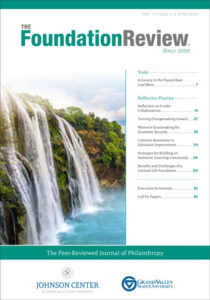Context Matters


We hope the articles in Vol. 12, Issue 2 encourage you to consider how you engage in context.
Enjoy exploring!

One of the contentious topics in philanthropy is the payout rate. During the current time of multiple crises (health, economic, and racial justice), many commentators are advocating for increased payout rates from foundations. In this article, Alexander constructs a metric using equity and bond market yields as a quantitative leading indicator of when a payout-rate change might be important to discuss. The quantitative approach he developed may be useful input to the ongoing debate, which also includes strategic and moral issues.
Another ongoing and contentious issue in the sector is the tension between local and national funders. Too often, local funders see national foundations who want to support work in communities but don’t value the experiences of long-term local funders. Here, the authors explore how The BUILD Health Challenge® was created and how it allows regional philanthropies the opportunity to inform the national agenda and contribute insights as to what works locally. Emerging evidence on benefits include shifts in confidence to take risks and new approaches to grantmaking.
In this article, the authors describe how the Medical College of Wisconsin’s Advancing a Healthier Wisconsin Endowment shifted to supporting adaptive rather than programmatic solutions to address critical health issues. The endowment’s new approach emphasized engagement with key stakeholders, recognizing the importance of contribution over attribution and requiring a long-term perspective on outcomes. The endowment works to translate new knowledge from national thought leaders and align it with its own experiences to guide the endowment’s work.
Gillespie draws our attention to an area that is poorly understood — how foundations are fostering economic security for women. She explores the work of Prosperity Together, a coalition of 30 women’s grantmaking funds dedicated to advancing women’s economic security, and argues that aligning the work with research recommendations is critical.
Jaquith and Chavez share the lessons of the Aligned Partners Project, a three-year study of a foundation-funded interorganizational collaboration to align the work of three technical assistance organizations to meet the needs of one school district. The focus on supporting the technical assistance providers helped to better coordinate services and support greater impact.
In another article focused on learning, the authors share findings from an evaluation of the Assessment for Learning Project, a grantee engagement strategy led by the Center for Innovation in Education focused on creating a learning community. The project’s model and approach are grounded in the core design elements of a field-facing learning agenda, grantmaking that leads with learning, collective leadership, and peer learning among grantees.
There has been increasing interest in limited-life foundations, with one argument in favor that as context changes, perpetual foundations are limited by the intent of the original donor and unable to be as responsive as needed. Here, Mansson explores this issue and other benefits and challenges of leading a foundation that is nearing the end of its life.
Not yet a subscriber? Click here to start your free 90-day trial.